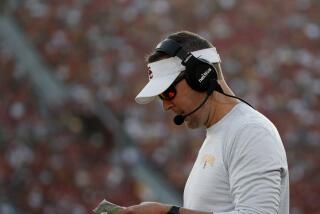Sportsmanship takes hit, yielding a cautionary tale
Not that anyone in the sport of football was particularly happy about LeGarrette Blount throwing the sucker punch seen ‘round YouTube.
But from the high school ranks to the NFL, coaches could take one comforting thought:
At least it wasn’t one of my players.
And in the days since Blount clocked an opponent and was suspended for the season, his mistake has been transformed into a teachable moment, an example to scare other athletes straight.
“It was a gift for all of us to see the bad end of things,” said USC Coach Pete Carroll, who addressed his team about keeping its cool.
The question is: Can the game actually benefit from an otherwise ugly situation? Noted sports ethicist Michael Josephson thinks it’s worth a shot.
“When things go wrong,” he said, “that’s a good opportunity to talk about a better way to do it.”
Things could not have gone more wrong for Blount last Thursday night.
The Oregon running back had suffered through a frustrating loss when Boise State defensive end Byron Hout tapped him on the shoulder pads and yelled something. Blount wheeled around, delivering a right cross that dropped Hout to the turf.
Later, an incensed Blount charged the stands, going after Boise State fans who heckled him.
The incident aired live on national television and was replayed incessantly on highlight shows and the Internet.
Ironically, it came at the very start of “Respect Weekend,” in which the NCAA and American Football Coaches Assn. encouraged teams to gather at midfield to shake hands before kickoff.
“This is a symbolic initiative that says to the football world, our fans, our students, our student-athletes and athletics departments that sportsmanship is a vital part of the successful football programs we have in this country,” AFCA Executive Director Grant Teaff said last week.
But even before Blount punched Hout, Georgia and Oklahoma State announced they would not take part in the pregame gesture.
“Our first concern was, [we’ll] have 115 guys out there and they’ll have 70,” Oklahoma State Coach Mike Gundy told reporters. “It just takes one guy to pop off.”
In the wake of the Blount incident, much of the debate has centered on specifics. Was his punishment too harsh? Did Hout deserve some of the blame? But some people have stepped back to consider broader issues.
They have wondered if sportsmanship is on the decline under a seemingly constant stream of taunting. They fear that stricter conduct penalties enacted in recent years have failed to change behavior.
In 2006, the NCAA targeted language as a “point of emphasis” regarding sportsmanship, and a year later added “an unsportsmanlike act toward an opponent that causes any opponent to retaliate by fighting” to it’s description of what should be penalized.
Last year, the California Interscholastic Federation’s Southern Section passed a rule that any athlete involved in a physical altercation should be ejected from the game and suspended from playing pending parental notification and a meeting with his or her high school principal.
“I would say that the percentage [of athletes who lash out] is minuscule,” Commissioner Jim Staunton said. “But it’s one of those deals where you really don’t want to see any problems.”
At the Josephson Institute, which works with athletes at all levels, Josephson praised Oregon for acting decisively.
“Imagine the same scenario if they gave him a two-game suspension,” the ethicist said. “A lot of it depends on whether the consequence is significant enough to be a deterrent.”
Because Blount is a senior, the suspension ended his college career, a point that coaches have since emphasized to their players.
“You mention how one mistake can hurt a person,” Arizona State Coach Dennis Erickson said.
Administrators said they need coaches to carry this message to the athletes. In the CIF’s City Section, which encompasses high schools throughout Los Angeles, coaches have been required to take Josephson’s three-hour workshop.
“They are absolutely the first line of defense,” Commissioner Barbara Fiege said. “We need them to model the proper behavior and enforce the rules.”
There has also been debate about Hout’s instigating the confrontation but, as of yet, he has faced only internal discipline from Boise State Coach Chris Petersen.
Pacific 10 Conference Commissioner Larry Scott, who was sitting beside Oregon Athletic Director Mike Bellotti at the end of the Boise State game, said he had contacted his counterpart at the Western Athletic Conference to express concern.
So far, the WAC has supported Boise State’s handling of the situation.
“It takes two to tango,” Scott said.
But Arizona Coach Mike Stoops delivered a different sort of message to his team: “You’ve got to learn not to react because . . . the person who reacts is the one who always has the most severe consequences.”
In the USC locker room after Saturday’s game against San Jose State, receiver Damian Williams agreed. He doesn’t condone fighting but said that taunting has always been part of the game.
While the junior says he thinks it is important to learn from what happened to Blount, he is not in favor of more rules.
“The NCAA has so many things they have to deal with,” he said. “I don’t think taunting enforcement is really needed that much.”
Meanwhile, Oregon will let Blount continue to practice this season. The school helped put him in touch with Kermit Washington, the former Laker whose punch badly injured Houston Rocket Rudy Tomjanovich in 1977.
Washington reportedly told Blount not to make any excuses.
--
More to Read
Go beyond the scoreboard
Get the latest on L.A.'s teams in the daily Sports Report newsletter.
You may occasionally receive promotional content from the Los Angeles Times.







